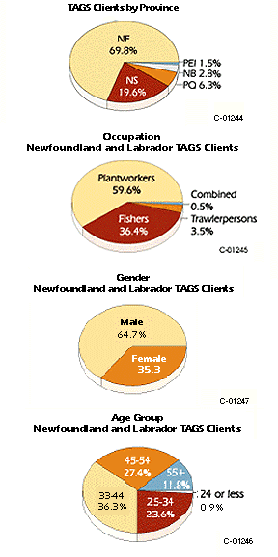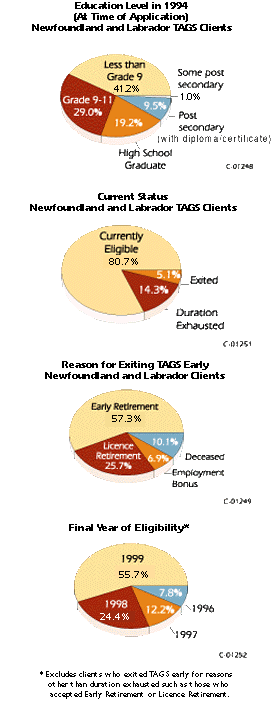 |
 |
Main characteristics of TAGS clients in Newfoundland and Labrador include the following:
About 60 percent of clients were attached to the fish processing component of the industry. It can be seen from the related figure that only a small proportion of the 40 percent who were fish harvesters worked on trawlers.
Fish harvesting has traditionally been a male dominated occupation while work in fish plants has typically been shared about equally between males and females. This is reflected in the distribution of TAGS clients by gender. About two-thirds are male and one-third are female.
About 88 percent of all TAGS clients are less than 55 years of age and about 60 percent are less than 45.
Formal education levels are generally low amongst Newfoundland and Labrador TAGS clients. For example, at the time when individuals applied for TAGS about 41 percent had less than Grade 9, while 70 percent had not completed high school. Only 10 percent of clients had formal training beyond high school. Workers may, however, have skill sets which are transferable to other occupations. While the acquisition of these skills may not have always come from formal accredited education and/or training, the skills may serve to aid TAGS clients in accessing other labour markets. Also, TAGS training since 1994 would have contributed to improvements in clients' credentials.
Eligibility for benefits and the length of time for which benefits can be collected was determined by historical attachment and income earned in the industry prior to the moratorium. Approximately 81 percent (22,530) of the total number who were initially granted access to TAGS were still eligible to receive TAGS benefits in May 1997.
The average benefit rate for those currently eligible is $295 per week. Male TAGS clients are eligible to receive higher benefits than female clients; the weekly rate for males is $320 as compared to $250 for females - reflecting the fact that most fish harvesters are male, and fish harvesters generally earned higher incomes. Therefore they receive higher TAGS benefits than fishplant workers. Plant workers can receive an average benefit of about $260 per week as compared with an average weekly benefit of $345 for trawler workers and fish harvesters.
The actual amount of benefits received by participants will vary from the eligible amount if income is attained from other sources. For example, if market income is earned, the amount of TAGS benefits paid will be reduced. For an overview of how benefits are calculated and how interactions with either labour market or employment insurance payments are treated, please refer to the box below.
| TAGS RATES AND DURATION OF
BENEFITS The TAGS benefit rate was based upon the average three year UI benefit rate received by UI claimants during the period from 1990 to 1992, less 6 percent. For individuals who had previously qualified for benefits under the Northern Cod Adjustment and Recovery Program (NCARP) the TAGS rate was equal to the NCARP rate, less 6 per cent. The duration of TAGS benefits was based upon the length of attachment to the fishery and ranged from 2 to 5 years; the average is 225 weeks, or 4.3 years. If a client receives Employment Insurance in any given week, the amount of the EI benefit payment is deducted from the TAGS benefit. Clients are permitted to earn 50 percent of their TAGS rate in fishery earnings and 25 percent of their TAGS rate in non-fishery employment earnings before any deductions are made. Employment earnings above the allowable amount are deducted from the client's TAGS benefit rate. The average weekly amount of TAGS benefits paid from April 27 to May 3, 1997, was $176, or, 60 percent of the amount that clients were eligible to receive. |
The number of clients who were scheduled to exhaust TAGS by year if the program were to run until 1999 is illustrated in the adjacent diagram. The statistics provide an indication of the proportion of clients who will lose access to the program earlier than expected if program funds run out as early as May 1998. Clients eligible for TAGS for the longest duration were those who demonstrated the longest attachment to the industry.